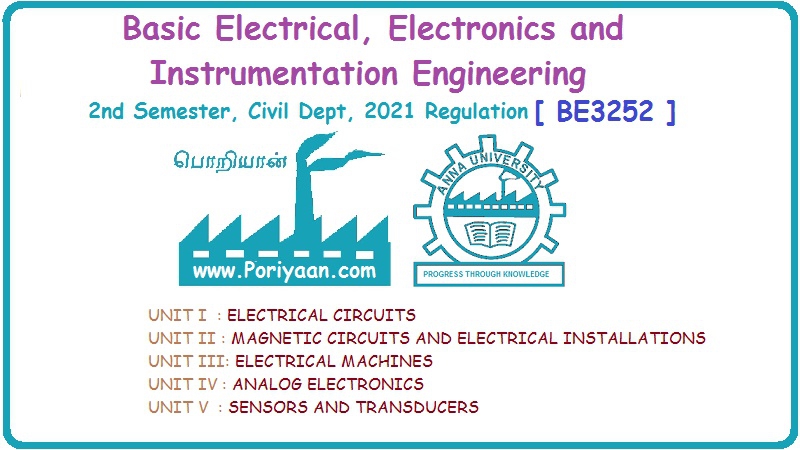Basic Electrical, Electronics And Instrumentation Engineering: UNIT I: Electrical Circuits
Simple Examples
Electrical Circuits: UNIT I: Dc Circuits: Examples
SIMPLE
EXAMPLES
Example 1.1:
A voltage of 125 V at 60 Hz is applied across a non-inductive resistor is
connected in series with capacitor. The current is 2.2 A. The power loss in
resistor is 96.8 W. Calculate the resistance and the capacitance. Neglect the
power loss in capacitor.

Example 1.2:
A coil having a resistance of 6 Q and an inductor of 0.03 H is connected across
a 100 V, 50 Hz supply. Calculated (i) Current, (ii) The phase angle between the
current and voltage, (iii) Power factor, (iv) Power.

Example 1.3:
A coil is having a resistance of 5 Ω and
an inductor of 6 H. What shall be the current when the coil is connected to 250
V, 50 Hz? Calculate the power in the circuit?

Example 1.4:
A coil of power factor 0.6 is in series with a 100 μF capacitor. When connected
to a 50 Hz supply, the potential difference across the coil is equal to the
potential difference across the capacitor. Find the resistance and inductance
of the coil.
Solution:

Example 1.5:
A series R-C circuit takes a power of 7000 watts when connected to 200 V, 50 Hz
supply. The voltage across the resistor is 130 Volts. Calculate (i) The
resistance, current, p.f, capacitance and impedance, (ii) Write the equations
for voltage and current.

Example 1.6: A
series circuit consisting of 25 Ω resistor, 64 mH inductor and 80 μF capacitor,
is connected to a 110 V, 50 Hz, single phase supply as shown in figure.
Calculate the current, voltage across individual element and the overall p.f of
the circuit. Draw a neat phasor diagram showing

Example 1.7:
A series circuit having pure resistance of 40 ohms, phase inductance of 50.07
mH and a capacitor is connected across a 400 V, 50 Hz, A.C supply. This R, L, C
combination draws a current of 10 A. Calculate (i) Power factor of the circuit
and (ii) Capacitor value.
Solution:

Example 1.8:
A circuit is composed of a resistance 6Ω and a series capacity reactance of 8Ω
A voltage e(t) = 141 sin 14t is supplied to the circuit. Find (i) Complex
impedance, (ii) Effective value of current, (iii) Power delivered to the
circuit, (iv) Capacitance of the capacitor.
Solution:
Figure
shows Rc
series circuit.

Example 1.9:
A series R-L-C circuit is connected to a 230 V, 50 Hz. 1-Phase AC supply the
value of R = 5 Ω, L= 13 mH and C = 140 μF. Find total reactance, impedance,
current drawn by the circuit and power factor of the circuit.
Solution:
Figure
shows RLC series circuit.

Example 1.10:
A resistance of 20 Ω and an inductance of 0.2 H and a capacitance of 100 μF are
connected in series across 220 V, 50 Hz main. Determine (i) impedance, (ii)
current taken from mains, (iii) power and power factor of the circuit.
Solution:

Example 1.11:
A series circuit having pure resistance of 40 N, pure inductance of 50 mH and a
capacitor is connected across a 400 V, 50 Hz ac supply. This RLC circuit draws
a current of 10 A. Calculate (i) Power factor of the circuit, (ii) Capacitor
Value.
Solution:

Example 1.12:
For the passive circuit consisting of resistances (in Ohms) as shown, calculate
the equivalent resistance between the terminals A and D.

Solution:
Between
the terminals A and D in the circuit given, the combination is neighter series
nor parallel. Hence, simplification is not possible as it is. So, we can
convert the delta between A, B and C into equivalent star. As a result, the
circuit becomes as drawn below:

Example 1.13:
For the network shown in the figure below, find the equivalent resistance
between the terminals B and C.

Solution:
The
given combination of resistances between the terminals B and C is neighter
series combination nor parallel combination. If, the star connection between A,
B and C is converted into equivalent delta, we will have a known combination
which can be simplified by series parallel simplification.

Example 1.14: Determine the equivalent
resistance between A and B.

The
combination is neighter series nor parallel. There is delta and star
connection. Converting the star connection for which N is the star point and
re-drawing the circuit, we get

Example 1.15: Determine the
equivalent resistance across AB of the circuit shown in the figure below.

Solution:
None
of the resistances in the circuit are connected in known fashion. There are
formations of deltas and stars as observed. Let us convert the inner delta into
equivalent 6 star. In the equivalent star the value of each resistance will be
=6/3 2 Ω.
Now, re-drawing 3 the original circuit after this conversion, we get the
following circuit.

In
the above figure, converting the inner star into its equivalent delta and
re-drawing the circuit, we get the following figure.

Basic Electrical, Electronics And Instrumentation Engineering: UNIT I: Electrical Circuits : Tag: : - Simple Examples
Related Topics
Related Subjects
Basic Electrical, Electronics and Instrumentation Engineering
BE3252 2021 Regulation | 2nd Semester Civil Dept 2021 Regulation
